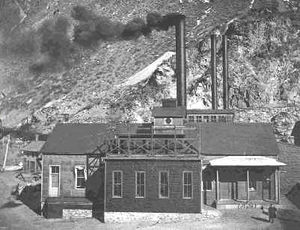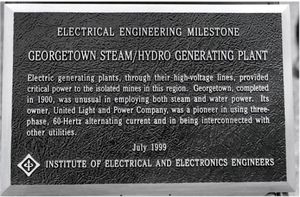Milestones:Georgetown Steam Hydro Generating Plant, 1900
Georgetown Steam/Hydro Generating Plant, 1900
Georgetown, CO, USA, Dedicated July 1999 - IEEE Denver Section
Electric generating plants, through their high-voltage lines, provided critical power to the isolated mines in this region. Georgetown, completed in 1900, was unusual in employing both steam and water power. Its owner, United Light and Power Company, was a pioneer in using three-phase, 60-Hertz alternating current and in being interconnected with other utilities.
The plaque can be viewed at the Georgetown Energy Museum, 600 Griffith Street, Georgetown, CO, U.S.A.
The mining industry brought about the early development of the alternating current (AC) electrical industry. The major mining areas for gold and silver were located in the mountain areas remotely located from streams that could provide water power for hydroelectric generating plants. The distances required for the transmission of electric power prohibited the use of direct current (DC) electric systems. Also, the major mining districts were in areas where coal was not available. The only fuel available was wood.
Photographs of 100 years ago, or more, taken in the heavy mining areas of Colorado show no timber. All the timber had been cut for three major reasons: first, for mine timbers; second, for fuel for the steam power used by many mines and mills; third, used for heating of homes and other buildings. The cost of cutting and hauling wood had become prohibitive. In certain areas mines were going bankrupt because of the high cost of wood. As it was stated above, because of the long distances required for the transmission of electric power, DC systems were useless. The alternative was AC power generation. AC could be generated at high voltages and transformers were available. By the end of 1891, AC power was not only accepted by the mining industry, but demanded a fast development of the AC electrical industry. The mining area around Georgetown, Colorado, following the pioneering of the Telluride Power Company (the Ames hydro plant was dedicated as an IEEE Milestone in July, 1988) demanded the early use of AC electric power. In April, 1891, The Electric Company installed a small AC hydroelectric generating plant in Hall's Mill in Georgetown, Colorado. This facility was used only for street lighting. All future development was for the mining industry.
The Georgetown Gas Company was organized in December of 1881. They constructed a gas retort and provided service to Georgetown of manufactured gas. A merger of The Electric Company and the Georgetown Gas Company came about with the organization of The United Light and Power Company in April, 1893. By June, 1893, a two-mile long electric line was constructed to provide AC power to Silver Plume, Colorado. Expansion of AC electric service developed rapidly. During July, 1900, construction of a five-mile transmission line to the mining area of Lamartine was begun. This was on a more or less straight line between Georgetown and Idaho Springs, Colorado, and led to the interconnection of the Georgetown steam/hydro plant with two other hydroelectric generating plants and the Cascade Electric Company in Idaho Springs, Colorado. At a later date, the United Light and Power Company was reorganized as the United Hydro Electric Company.

